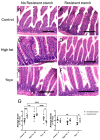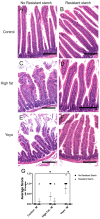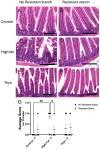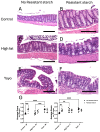Deleterious Effects of Yoyo Dieting and Resistant Starch on Gastrointestinal Morphology
- PMID: 39683609
- PMCID: PMC11644255
- DOI: 10.3390/nu16234216
Deleterious Effects of Yoyo Dieting and Resistant Starch on Gastrointestinal Morphology
Abstract
Background: Obesity is associated with structural deterioration in the gut. Yoyo dieting, which refers to repeated phases of dieting and non-dieting periods leading to cyclic weight loss and regain, is a common occurrence in individuals with obesity. However, there is limited evidence on how gut structures are affected in yoyo dieting. There is good evidence suggesting that increased intake of resistant starch (RS) may be beneficial in promoting structural improvements in the gut. This investigation aimed to explore the effect of yoyo dieting on gastrointestinal structure and whether RS has beneficial effects in improving obesity-related gastrointestinal damage.
Method: In this study, male and female C57BL/6 mice were assigned to six different diets for 20 weeks: (1) control diet, (2) high fat diet (HF), (3) yoyo diet (alternating HF and control diets every 5 weeks), (4) control diet with RS, (5) HF with RS, and (6) yoyo diet with RS. Distal colon was collected for epithelial barrier integrity measurement. The small and large intestines were collected for histological assessment.
Results: After 20 weeks, yoyo dieting resulted in increased colonic inflammation and exacerbated mucosal damage in comparison with continuous HF diet feeding. RS supplemented in HF and yoyo diets reduced mucosal damage in comparison to diets without RS. However, RS supplementation in a control diet significantly increased inflammation, crypt length, and goblet cell density. There were no significant differences in epithelial change and epithelial barrier integrity across diet groups.
Conclusions: This study suggests that yoyo dieting worsens gut damage, and incorporating high levels of RS may be detrimental in the absence of dietary challenge.
Keywords: gastrointestinal structures; inflammation; resistant starch; weight cycling; yoyo dieting.
Conflict of interest statement
The authors declare no conflicts of interest.
Figures









Similar articles
-
The Impact of Yoyo Dieting and Resistant Starch on Weight Loss and Gut Microbiome in C57Bl/6 Mice.Nutrients. 2024 Sep 17;16(18):3138. doi: 10.3390/nu16183138. Nutrients. 2024. PMID: 39339738 Free PMC article.
-
Yoyo Dieting, Post-Obesity Weight Loss, and Their Relationship with Gut Health.Nutrients. 2024 Sep 19;16(18):3170. doi: 10.3390/nu16183170. Nutrients. 2024. PMID: 39339770 Free PMC article. Review.
-
Potato-Resistant Starch Supplementation Improves Microbiota Dysbiosis, Inflammation, and Gut-Brain Signaling in High Fat-Fed Rats.Nutrients. 2019 Nov 8;11(11):2710. doi: 10.3390/nu11112710. Nutrients. 2019. PMID: 31717368 Free PMC article.
-
The modulatory effect of pea resistant starch on hyperlipidemia in high fat diet-induced obese mice is related to their supramolecular structural features.J Sci Food Agric. 2025 Jun;105(8):4633-4644. doi: 10.1002/jsfa.14252. Epub 2025 Mar 31. J Sci Food Agric. 2025. PMID: 40165353
-
Dietary glycation compounds - implications for human health.Crit Rev Toxicol. 2024 Sep;54(8):485-617. doi: 10.1080/10408444.2024.2362985. Epub 2024 Aug 16. Crit Rev Toxicol. 2024. PMID: 39150724
References
-
- Australian Institute of Health and Welfare . Australian Burden of Disease Study 2018: Interactive Data on Risk Factor Burden. Australian Institute of Health and Welfare; Canberra, Australia: 2018.
-
- World Obesity Federation . World Obesity Atlas 2023. World Obesity Federation; London, UK: 2023.
-
- World Health Organisation . Obesity and Overweight. WHO; Geneva, Switzerland: 2016.
MeSH terms
Substances
LinkOut - more resources
Full Text Sources
Research Materials
Miscellaneous

